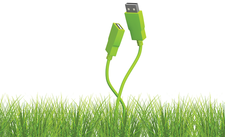Assessing the environmental impact of software
Efficiency Angel

Germany created Blue Angel, the world's first eco-label for software, back in 2000. The methodology behind Blue Angel could serve as a model for other countries as governments turn their attention to the environmental impact of software.
It is one of those annoying things that I hope consumers will never get used to, nor should they accept it. A device that costs a large amount of money is suddenly no longer of use simply because the required security update is not available. Or perhaps the new application software needs more powerful components or the interfaces are incompatible with other devices? In all these cases, consumers have no option but to replace devices that are actually still working. In other words, the software forces an unnecessary upgrade to the hardware. This common scenario can lead to significant waste of energy and raw materials.
The greatest environmental impact from information and communications technology products happens during the manufacturing process. A rumor still persists that replacing existing technology with more energy-efficient technology is good for climate protection, but the truth is, considerably higher CO2 emissions are produced during manufacture of that "energy efficient" device than during use, so in many cases, the best thing you can do for the environment is keep using the device you already have rather than drive demand for more production.
Now you could argue that short replacement cycles would not be so bad if accompanied with an effective program for recycling. But, in practice, recycling processes do not exist for some metals, which means that valuable materials are irretrievably lost when you throw away a computer. Large quantities of electronic scrap ends up in landfills.
[...]
Buy this article as PDF
(incl. VAT)
Buy Linux Magazine
Subscribe to our Linux Newsletters
Find Linux and Open Source Jobs
Subscribe to our ADMIN Newsletters
Support Our Work
Linux Magazine content is made possible with support from readers like you. Please consider contributing when you’ve found an article to be beneficial.

News
-
Mozilla Plans to AI-ify Firefox
With a new CEO in control, Mozilla is doubling down on a strategy of trust, all the while leaning into AI.
-
Gnome Says No to AI-Generated Extensions
If you're a developer wanting to create a new Gnome extension, you'd best set aside that AI code generator, because the extension team will have none of that.
-
Parrot OS Switches to KDE Plasma Desktop
Yet another distro is making the move to the KDE Plasma desktop.
-
TUXEDO Announces Gemini 17
TUXEDO Computers has released the fourth generation of its Gemini laptop with plenty of updates.
-
Two New Distros Adopt Enlightenment
MX Moksha and AV Linux 25 join ranks with Bodhi Linux and embrace the Enlightenment desktop.
-
Solus Linux 4.8 Removes Python 2
Solus Linux 4.8 has been released with the latest Linux kernel, updated desktops, and a key removal.
-
Zorin OS 18 Hits over a Million Downloads
If you doubt Linux isn't gaining popularity, you only have to look at Zorin OS's download numbers.
-
TUXEDO Computers Scraps Snapdragon X1E-Based Laptop
Due to issues with a Snapdragon CPU, TUXEDO Computers has cancelled its plans to release a laptop based on this elite hardware.
-
Debian Unleashes Debian Libre Live
Debian Libre Live keeps your machine free of proprietary software.
-
Valve Announces Pending Release of Steam Machine
Shout it to the heavens: Steam Machine, powered by Linux, is set to arrive in 2026.

